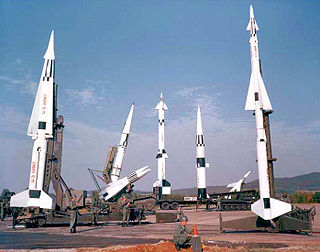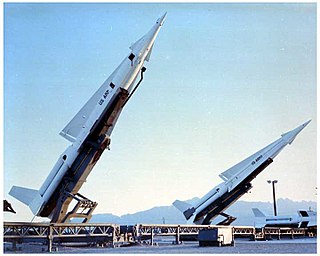
The MIM-104 Patriot is a surface-to-air missile (SAM) system, the primary such system used by the United States Army and several allied states. It is manufactured by the U.S. defense contractor Raytheon and derives its name from the radar component of the weapon system. The AN/MPQ-53 at the heart of the system is known as the "Phased Array Tracking Radar to Intercept on Target", which is a backronym for "Patriot". Starting in 1984, the Patriot system began to replace the Nike Hercules system as the U.S. Army's primary High to Medium Air Defense (HIMAD) system and the MIM-23 Hawk system as the U.S. Army's medium tactical air defense system. In addition to these roles, Patriot has been given a function in the U.S. Army's anti-ballistic missile (ABM) system. The system is expected to stay fielded until at least 2040.

Project Nike was a U.S. Army project, proposed in May 1945 by Bell Laboratories, to develop a line-of-sight anti-aircraft missile system. The project delivered the United States' first operational anti-aircraft missile system, the Nike Ajax, in 1953. A great number of the technologies and rocket systems used for developing the Nike Ajax were re-used for a number of functions, many of which were given the "Nike" name . The missile's first-stage solid rocket booster became the basis for many types of rocket including the Nike Hercules missile and NASA's Nike Smoke rocket, used for upper-atmosphere research.

The Nike Hercules, initially designated SAM-A-25 and later MIM-14, was a surface-to-air missile (SAM) used by U.S. and NATO armed forces for medium- and high-altitude long-range air defense. It was normally armed with the W31 nuclear warhead, but could also be fitted with a conventional warhead for export use. Its warhead also allowed it to be used in a secondary surface-to-surface role, and the system also demonstrated its ability to hit other short-range missiles in flight.

The Raytheon MIM-23 HAWK is an American medium-range surface-to-air missile. It was designed to be a much more mobile counterpart to the MIM-14 Nike Hercules, trading off range and altitude capability for a much smaller size and weight. Its low-level performance was greatly improved over Nike through the adoption of new radars and a continuous wave semi-active radar homing guidance system. It entered service with the US Army in 1959.

NASAMS is a distributed and networked short- to medium-range ground-based air defense system developed by Kongsberg Defence & Aerospace (KDA) and Raytheon. The system defends against unmanned aerial vehicles (UAVs), helicopters, cruise missiles, unmanned combat aerial vehicles (UCAVs), and fixed wing aircraft, firing any of a wide range of existing missiles.
Ground-directed bombing (GDB) is a military tactic for airstrikes by ground-attack aircraft, strategic bombers, and other equipped air vehicles under command guidance from aviation ground support equipment and/or ground personnel. Often used in poor weather and at night, the tactic was superseded by an airborne computer predicting unguided bomb impact from data provided by precision avionics Equipment for radar GDB generally included a combination ground radar/computer/communication system and aircraft avionics for processing radioed commands.

The 32nd AAMDC or 32nd Army Air and Missile Defense Command is a theater level Army air and missile defense multi-component organization with a worldwide, 72-hour deployment mission. The 32nd AAMDC commands echelon above corps (EAC) ADA brigades and other assigned forces. Four such brigades, 11th Air Defense Artillery Brigade, 31st Air Defense Artillery Brigade, 69th Air Defense Artillery Brigade, and 108th Air Defense Artillery Brigade; by training, all stand ready to accomplish their mission of air defense against missile attack – 'anywhere, anytime' in support of the war-fighting combatant commander (CCDR).
The Martin AN/FSG-1 Antiaircraft Defense System, better known as Missile Master, was an electronic fire distribution center to computerize Cold War air defense (AD) command posts from manual plotting board operations to automated command and control of remote surface-to-air missile (SAM) launch batteries. The 10 United States Army C3 systems used radar netting ("electronic umbrella") at Missile Master military installations for coordinating ground-controlled interception by Nike and MIM-23 Hawk missiles. The vacuum tube fire control logic reduced the time to designate the appropriate missile battery to launch if an enemy target had intruded into a defense area where an AN/FSG-1 system was deployed.
The Hughes AN/TSQ-51 Air Defense Command and Coordination System was a transportable electronic fire distribution center for automated command and control of remote Nike missile launch batteries. The radar netting system replace the vacuum tube AN/FSG-1 in 6 United States Missile Master bunkers after the upgrade was approved by the United States Department of Defense in 1963; and additional deployments were at Homestead-Miami, Florida, and Providence, Rhode Island, to replace Battery Integration and Radar DIsplay Equipment (BIRDIE) systems; as well as at San Francisco. As with the AN/FSG-1, the AN/TSQ-51 could provide fire control for 24 Nike batteries, but the smaller AN/TSQ-51 could be fielded in 2 trailers.

Missile Master was a type of US Army Missile Command military installation for the Cold War Project Nike, each which were a complex of systems and facilities for surface-to-air missile command and control. Each Missile Master had a nuclear bunker housing the Martin AN/FSG-1 Antiaircraft Defense System, as well as additional "tactical structures" for "an AN/FPS-33 defense acquisition radar (DAR) or similar radar, two height-finder radars," and identification friend or foe secondary radar. The radars, along with Automated Data Links (ADL) from remote Nike firing units, provided data into the AN/FSG-1 tracking subsystem with the DAR providing surveillance coverage to about 200 mi (320 km).
The Martin AN/GSG-5 Battery Integration and Radar DIsplay Equipment (BIRDIE) was a transportable electronic fire distribution center for automated command and control of remote surface-to-air missile launch batteries. The solid state radar netting system replaced the vacuum tube AN/FSG-1 at 3 United States Missile Master bunkers and BIRDIEs were deployed at over 25 US locations including Homestead-Miami, Florida; Providence, Rhode Island; and San Francisco. The AN/GSG-5 with 3 consoles was a direction center for up to 16 Nike missile batteries, but a smaller variant with only 1 console and without computer and storage equipment could control only 2 batteries and was the 1st BIRDIE deployed. Several BIRDIE systems were replaced by Hughes AN/TSQ-51 Air Defense Command and Coordination Systems, and the last AADCP with an AN/GSG-5 was at Ft Lawton on July 1, 1973.

The Highlands Army Air Defense Site (HAADS) was a United States Army air defence site in Middletown Township, New Jersey.

The Reeves AN/MSQ-77 Bomb Directing Central, Radar was a USAF automatic tracking radar/computer system for command guidance of military aircraft during Vietnam War bomb runs at nighttime and during bad weather. Developed from the Reeves AN/MSQ-35, the AN/MSQ-77 reversed the process of Radar Bomb Scoring by continually estimating the bomb impact point before bomb release with a vacuum tube ballistic computer. Unlike "Course Directing Centrals" which guided aircraft to a predetermined release point, the AN/MSQ-77 algorithm continuously predicted bomb impact points during the radar track while the AN/MSQ-77's control commands adjusted the aircraft course. A close air support regulation prohibited AN/MSQ-77 Combat Skyspot bombing within 1,000 yd (910 m) of friendly forces unless authorized by a Forward Air Controller, and "on several occasions" strikes were as close as 273 yd (250 m).

The Western Electric System 1393 Radar Course Directing Central (RCDC) was a Cold War complex of radar/computer systems within the overall Improved Nike Hercules Air Defense Guided Missile System. The RCDC was installed at the "battery control areas" of ~5 hectares each which was for commanding a nearby missile Launching Area (LA), firing a missile from the LA, and guiding a launched missile to a burst point near an enemy aircraft.
The Martin AN/TSQ-8 Coordinate Data Set was a Project Nike CCCS system for converting data between Army Air Defense Command Posts (AADCP) and Integrated Fire Control sites for missile Launch Areas. The AN/TSQ-8 in the Firing Unit Integration Facility (FUIF) was first installed for each Launch Area controlled from a Martin AN/FSG-1 Antiaircraft Defense System and then later for other Nike CCCS. The system included a "data converter, range computer, summing amplifier, status relay panel, status control panel, problem unit, [and] power control panel".
Radar Bomb Scoring is a combat aviation ground support operation used to evaluate Cold War aircrews' effectiveness with simulated unguided bomb drops near radar stations of the United States Navy, the USAF Strategic Air Command, and Army Project Nike units. USAF RBS used various ground radar, computers, and other electronic equipment such as jammers to disrupt operations of the bomber's radar navigator, AAA/SAM simulators to require countermeasures from the bomber, and Radar Bomb Scoring Centrals for estimating accuracy of simulated bombings. Scores for accuracy and electronic warfare effectiveness were transmitted from radar sites such as those at Strategic Range Training Complexes.
A command, control, and coordination system (CCCS) was a Cold War computer system for United States command posts to use a single location to coordinate multiple units' ground-controlled interception and may refer to:
The Western Electric M-33 Antiaircraft Fire Control System was an X-Band "Gunfire Control Radar", for aiming antiaircraft artillery by computer control. Developed for mobility via 3 trailers, the "M-33 system could compute, for the 90-mm. and 120-mm. guns, firing data for targets with speeds up to 1,000 mph", and for targets at 120,000 yards had similar gun laying accuracy as "SCR-584 type radars" at 70,000 yards. The system included a telescopic "target selector" on a tripod near the guns for additional measurement of aircraft "azimuth and elevation data [to] be transmitted to the computer and utilized as gun directing data."

The Fort Heath radar station was a USAF radar site and US Army Missile Master installation of the joint-use site system (JUSS) for North American Air Defense at a former coastal defense site. The Cold War radar station had 2 USAF AN/FPS-6B height finding radars, 2 Army AN/FPS-6A height finders, an FAA ARSR-1 radar emplaced 1958-9, and an Army nuclear bunker. Arctic Towers were the pedestals for the FPS antennas and radomes, while the Air Route Surveillance Radar was on a 50-foot extension temperate tower adjacent to the Federal Aviation Administration building.












